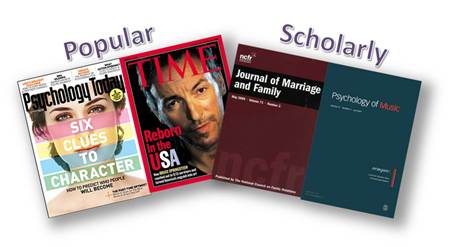Writing a Report
26 Finding and Evaluating Research Sources
Quality professional writing is driven by reasoning and evidence. Evidence is gathered through the research process and researchers need to ensure that they are relying on quality evidence sources. That means you’ll need to evaluate the sources to determine whether they merit use in a professional document.
Popular versus scholarly sources
So much information is available at our fingertips on the Internet, but so much of it is unreliable. When there is no barrier to publishing, there is often no quality control. Students need to critically search through the reams of information in order to select credible sources that can provide reliable data to support ideas and convince an audience. In the era of “fake news,” deliberate misinformation, and “alternative facts,” developing the skill to evaluate the credibility of sources is essential.
Sources can be broken up into two categories: popular and scholarly. How would you define the difference between the two? Can you come up with some examples of both? Ideally, when you think of both categories, you should think of items such as those in the figure below.

Figure #2: Examples of popular versus scholarly sources.[1]
Why are scholarly sources more desirable than popular sources? Let’s look at this a little more deeply.
Take a look at this chart from the Douglas College Library. It recommends scrutinizing the sources you find for five key points: credibility, accuracy, reasonableness, support, and suitability.
When you look at a scholarly article, you will see the authorship and can check whether or not they are an expert in their field. You can see the sources the article is citing, so you can independently evaluate the quality of the evidence they’re using. They disclose the methods they’ve used for collecting data, so you can decide if their process was a reliable way of producing new information. You’ll also notice that scholarly research discusses its own weaknesses and limitations, which is reasonable and fair.
When you look at other online sources, do you see them passing these tests? Sometimes, the answer is “yes,” which is great. However, other times, you realize you can’t see who wrote the article or when. You don’t know what motivated them or whether they’re an expert. They may not cite their sources. These are all red flags.
Scholarly articles published in academic journals are usually required sources in professional communication; they are also an especially integral part of engineering projects and technical reports. Since you are researching in a professional field and preparing for the workplace, there are many credible kinds of sources you will draw on in a professional context, such as government statistics, trade publications, industry reports, and official records.
Critically evaluating sources
Clearly, there are a lot of places where you can pull sources from. However—and this is a big however—you must critically evaluate your sources for authority, content, and purpose.
Anyone can put anything on the internet and people with strong web and document design skills can make this information look very professional and credible, even if it isn’t. Since a majority of research is currently done online, and many sources are available electronically, developing your critical evaluation skills is crucial to finding valid, credible evidence to support and develop your ideas. In fact, this has become such a challenging issue that there are sites, such as Beall’s List of potential predatory journals and publishers, that regularly update its online list of journals that subvert the peer review process and simply publish for profit.
When evaluating research sources and presenting your own research, be careful to critically evaluate the authority, content, and purpose of the material, using the questions found here: Evaluating the Authority, Content, and Purpose of the Information.
Going through all those questions may seem like a tedious, unnecessary process, but you need to consider these questions as you acquire sources for your reports. Not doing so can negatively impact your credibility as a professional.
Consider it this way: let’s say you are presenting a report to a potential client. If they find out you used sources that lack authority, are not relevant or recent, or do not really serve their purpose, how will they view you? How will that affect their view of the company you work for?
Ultimately, critical thinking lies at the heart of evaluating sources. You want to be rigorous in your selection of evidence, because once you use it in your paper, it will either bolster your own credibility or undermine it.
References
Kurland, D. (2000). What is critical thinking? How the language really works: The fundamentals of critical reading and effective writing. https://www.criticalreading.com/critical_thinking.htm
Attributions
This chapter was adapted from Effective Professional Communication: A Rhetorical Approach by Rebekah Bennetch, Corey Owen, and Zachary Keesey, which is licensed under a Creative Commons Attribution-NonCommercial-ShareAlike 4.0 International License, except where otherwise noted.
Bennetch, Owen, and Keesey adapted their chapter from Technical Writing Essentials (on BCcampus) by Suzan Last, and is used under a Creative Commons Attribution 4.0 International License.
sources that are typically peer-reviewed by experts, more technical in nature, and cite references
sources that are good for background information and ideas, but not for including in actual research
a quality that allows others to trust and believe you
an account of your investigation into a subject, presented in a written document or oral presentation that has conventional formatting

